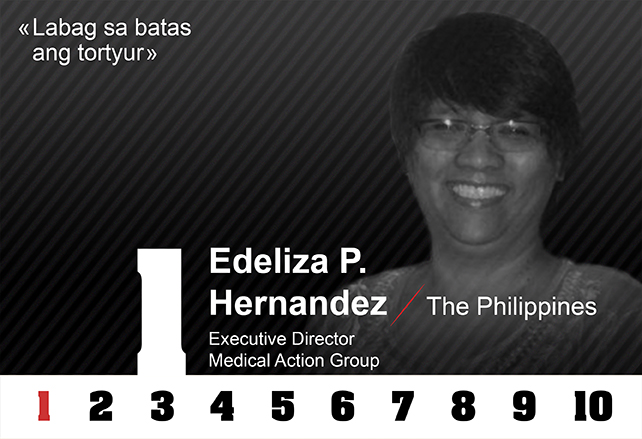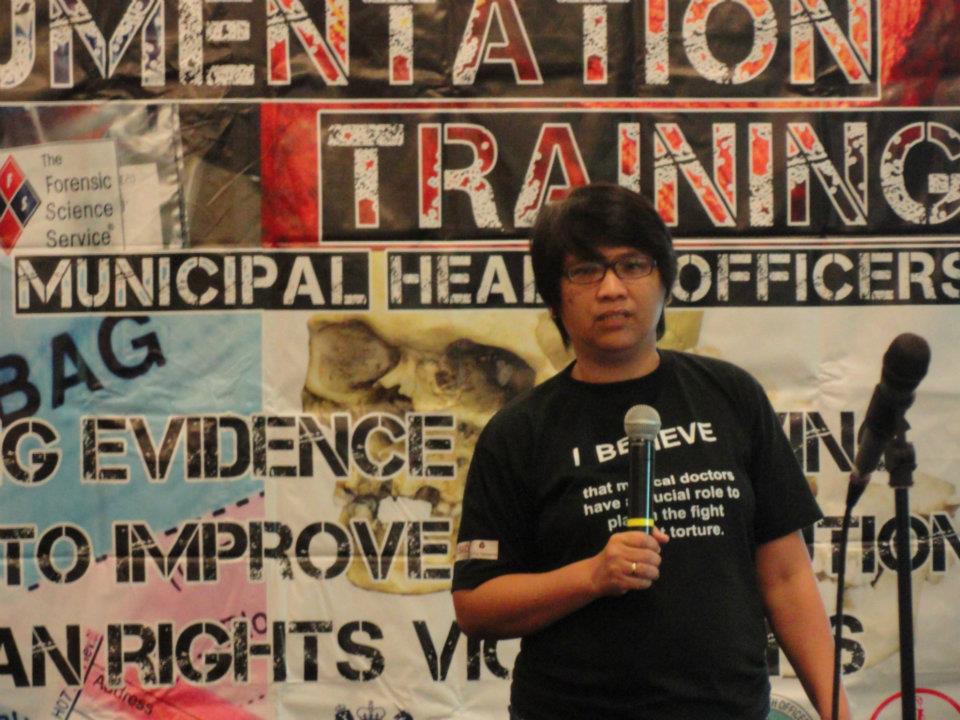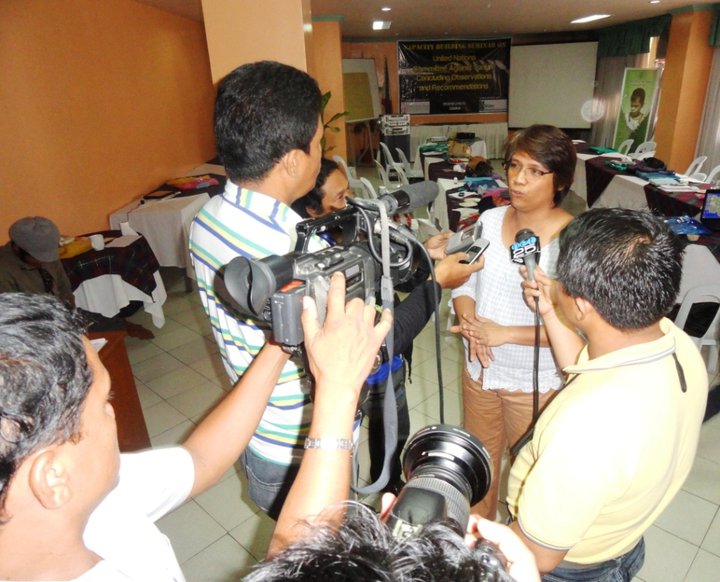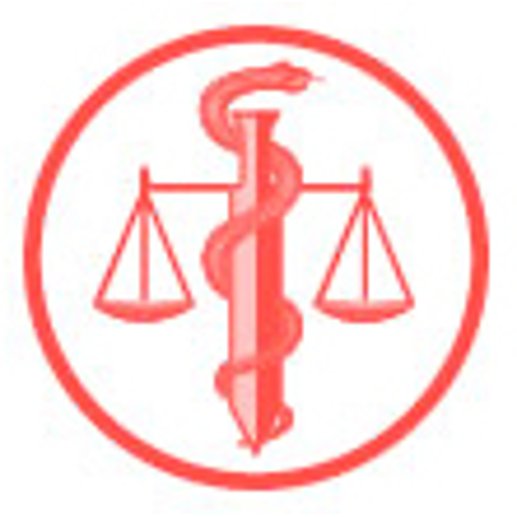
Please, briefly introduce yourself.
I am Ms. Maria Natividad Hernandez (also fondly called my colleagues and friends “Edeliza”), a health professional and a human rights defender. I am the Executive Director of the Medical Action Group (MAG) https://magph.org.org/ since 2001 and a Council member of the International Rehabilitation Council for Torture Victims for the term 2012-2015. In this capacity, I have gained a huge experience in documenting cases of torture and other forms of human rights violations particularly in providing treatment for torture survivors. From my academic and professional experience in the right to health and anti-torture movement, I am not only equipped with knowledge and skills on the fight against torture, I am as well guided by critical and sharp understanding of the dynamics of the human rights movement in the Philippines.
For many years, I have participated in many human rights fact-finding missions and visited prisons in the Philippines and since 2001, I have been conducting capacity building activities on the popularization of and familiarization on the use of the UN Manual on Effective Investigation and Documentation of Torture and Other Cruel, Inhuman or Degrading Treatment or Punishment (“the Istanbul Protocol”) among doctors and health professionals.
I have been part of the Technical Working Group (TWG) on crafting the Anti-Torture Act of the Philippines as well as its Implementing Rules and Regulations. I have been exposed to many international human rights work representing MAG to the various set of conferences such as the UN Committee Against Torture, the World Health Organization (WHO) Country Cooperation Strategy Multi Stakeholders Consultative meeting in October 2010 and validation and 2012-2013 Biennium Planning last February 2011.
As a specialized trainer on the use of the Istanbul Protocol, I have co-authored several publications, information materials and research studies on right to health focused particularly on providing care for torture survivors based on the Istanbul Protocol.
For most of my professional life, I have worked for various NGOs as a member of the Board of Trustees of the Philippine Alliance of Human Rights Advocates (PAHRA) and the Philippine Coalition for the International Criminal Court (PCICC).
I am 51 years old, married and with three children.

Today, what is the biggest challenge in the fight against torture in your country? Can you take stock of the situation of torture and ill-treatment in your country (the context, the extent of the problem, the type of victims and perpetrators, etc.)?
Impunity and insufficient evidence in torture cases against alleged perpetrators are still among the serious impediments to the prevention of torture. Consequently, few complaints are brought forward and few actual prosecutions are made.
The Philippines’ Anti-Torture Law or Republic Act (RA) No. 9745, which was enacted in 2009, has a very strong component relating to victim’s access to a physical, medical and psychological examination to be conducted in connection with all torture investigations which is based on the standards in the Istanbul Protocol.
Torture victims however rarely have access to a legal counsel and a medical doctor immediately after arrest and during detention.
The lack of formal knowledge and capacity of the investigating authorities and medical doctors who are often among the first persons to come into contact with torture survivors on the Anti-Torture Act and the Istanbul Protocol create reluctance on their part to investigate and document torture cases.
The investigations conducted by authorities concerning allegations of torture are either completely unreliable, if they document a torture incident at all. In some cases, arresting police officers facilitate medical examination after inquest, but they were seen by doctors assigned to major police or military health centers or to government hospitals who gave them cursory “check list” physical examinations with no questions about how torture marks may have been inflicted. Thus, the medical certificates they issue are frequently summary in nature referring only to visible bruises or contusions with a formulaic assessment of how long the torture victims is likely to need medical treatment.
Torture victims couldn’t get redress because some doctors don’t perform their medical examination properly and diligently either due to low awareness on forensic documentation of torture cases, because they are intimidated by authorities, or both. The lack of quality documentary and testimonial evidence offer a good excuse to close or dismiss most investigations at the preliminary investigation stage by the prosecutors. The lacklustre consideration of prosecutors and judges of medical reports as evidence to litigate torture complaints is another reason why torture victims are discouraged from seeking redress anymore. This appears to be a predicament in a country where the rule of law is weak and the culture of impunity pervasive in the country.
This situation emphasizes the role that medical documentation and proper legal processes play in the investigation and prosecution of cases of torture and other human rights violations.
One of the documented torture cases by MAG which briefly illustrate the “weak” aspect of prosecuting torture case is the case of Lenin Salas et al against PSupt. Madgzgani Mukaram of the Pampanga Provincial Public Safety Office of Pampanga. The prosecutor in City of San Fernando, Pampanga dismissed a torture complaint against the police on July 21, 2011, on the basis that the victim, who was blindfolded during torture, could not positively identify those responsible.
The medical professionals are in essence a key to prevent impunity. The medical documentation and medico-legal reports (MLR) they write are important facts that can be used as pieces of evidence in legal or administrative proceeding for prosecuting torture cases and facilitating redress and reparation for survivors.
The need to increase the capacity of investigators in handing evidences and prosecutors in evaluating physical and medical evidences represents recognition that effective and quality documentation of alleged torture cases can contribute mightily to reducing impunity in the Philippines and obtaining redress for torture victims.

According to your experience, what are the root causes of torture and impunity?
Most of the victims and survivors of torture belong to the poorest and most disadvantaged sectors of the society. The failure of the State to protect, promote and respect human rights including poverty and corruption are the root causes of torture and impunity. Likewise, one of the most importance root causes of torture is the malfunctioning of the administration of justice in many countries.
What is your approach and what kind of activities do you carry out to fight against torture and ill-treatment in your country? Can you give us examples of achievements linked to these activities?
The MAG has established its credibility in torture prevention in the Philippines by capacity building of doctors and legal professionals on the documentation and reporting cases of torture, and monitoring of the government’s compliance with the UNCAT through the implementation of following projects among others: “Preventing Acts of Torture and Other Human Rights Violations Through the Medical Documentation by the Municipal and City Health Officers (C/MHOs)” (BEM, 2011-2012) and “Combating Torture in the Philippines through Monitoring the Government’s Compliance with the UN Committee Against Torture Concluding Observations” (DKA-Austria, 2010-2013).
What obstacles do you encounter daily when carrying out your activities?
On the ground, the obstacles are corruption in the government, restrictive guidelines in jail visitation of the Philippine National Police (PNP), Bureau of Jail Management and Penology (BJMP) and other custodial and prison institutions, lack of coordination among government agencies in implementing the Anti-Torture Law among others and low level of awareness of public prosecutors on evaluation of medical evidence in relation to legal action pertaining to torture cases and of medical doctors on the use of the Istanbul Protocol in documenting torture cases.
Do you feel threatened because of your activities? Do you face any interference in your work? If this is the case, can you kindly precise.
Yes. The “vilification campaign” by the State security forces against human rights organizations and CSOs who are labelled as “communist front” or associated with rebel groups.
What needs to be done so that « Nothing justifies torture » becomes a reality in your country?
MAG has increased its capacity to represent the organization in policy-level dialogue and has contributed in the increase awareness among key national government agencies and institutions in the fight against torture, in particular in the systematic use of the Istanbul Protocol for the documentation of torture cases and right of persons deprived of liberty to prompt and immediate access to medical examination.
Sustaining and strengthening this high-level of partnership with the Commission on Human Rights (CHR) and government agencies such as the Department of Health (DOH) and the Department of Justice (DOJ) are crucial in continuing education among the public on the prevention of torture and to bring more transparency in the prisons and jails in the country.
More important is the fundamental change in the political priorities of the government in addressing the root cause of torture by effectively implementing laws and combating corruption in the judicial sector.
What part plays and should play the public opinion in the fight against torture and what can the public do to support the fight against torture?
The public plays a very important role to heighten awareness about the issue of and fight against torture and increase public support for the prevention of torture and rehabilitation of torture victims. The public can take part in the fight against torture through the use of social media by uploading and posting relevant information on the prevention of torture. Likewise, they can build network of anti-torture advocates and support group for torture survivors in their respective locality.
Source: www.omct.org/human-rights-defenders/events/2012/12/d22052/?fb_action_ids=4913158904209&fb_action_types=og.recommends&fb_source=timeline_og&action_object_map={“4913158904209″%3A302283163215795}&action_type_map={“4913158904209″%3A”og.recommends”}&action_ref_map=[]

